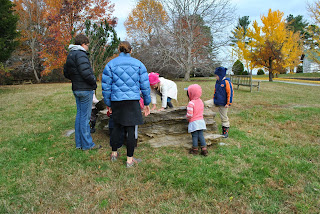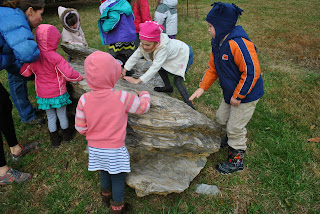Wishing you all a Happy Thanksgiving! See you next week.
The focus of Advent is preparation for the coming of the Lord -- both in commemoration of His Nativity and His coming again at the end of time. Though most Protestants -- and far too many Catholics -- see this time of year as a part of the "Christmas Season," it isn't; the Christmas season does not begin until the first Mass at Christmas Eve, and doesn't end liturgically until the Octave of the Epiphany on January 14. It goes on in the spiritual sense until Candlemas on February 2, when all celebrations of Christ's Childhood give way to Septuagesima and Lent.
The mood of this season is one of somber spiritual preparation that increases in joy with each day, and the gaudy "Christmas" commercialism that surrounds it in the Western world should be overcome as much as possible. The singing of Christmas carols (which comes earlier and earlier each year), the talk of "Christmas" as a present reality, the decorated trees and the parties -- these things are "out of season" for Catholics; we should strive to keep the Seasons of Advent holy and penitential, always remembering, as they say, that "He is the reason for the Season."
To sum up the similarities and differences between Advent and Lent as penitential seasons, there's this, by Fr. Lawrence Smith:
Advent is the time to make ready for Christ to live with us. Lent is the time to make us ready to die with Christ. Advent makes Lent possible. Lent makes salvation possible. Advent is the time when eternity approaches earth. Lent is the time when time reaches consummation in Christ's eternal Sacrifice to the Father. Advent leads to Christ's life in time on earth. Lent leads to Christ's eternal Life in Heaven. The Cross -- through the Mass, penance, and mortification -- is the bridge connecting Advent and Lent, Christ and His Church, man and God.Catholic apologist Jacob Michael wrote something very interesting about how secular America sees "Christmas" as beginning after Thanksgiving and ending on 25 December, and then makes "New Years Resolutions" at the beginning of the secular year:
Each of the Church's penitential seasons is a dying to the world with the goal of attaining new life in Christ.
...what Christians do (or should be doing!) during Advent and leading up to Christmas is a foreshadowing of what they will do during the days of their lives that lead up to the Second Coming; what non-Christians refuse to do during Advent, and put off until after Christmas, is precisely a foreshadowing of what they will experience at the Second Coming.So please, restore Advent and don't think "Christmas is here" until it truly comes. One way to help focus on the theme of preparation is to read the parables of The Fig Tree, The Man Going on a Long Journey, The Faithful and Wicked Stewards, and The Ten Virgins in the 24th and 25th chapters of St. Matthew's Gospel. Another way to help you do this is to think of the Saint who embodies the spirit of this Season more than any other: the great St. John the Baptist. If you have an icon of him, venerate it especially now. Make special prayers to him and consider the message of this "voice of one crying in the desert": "Prepare ye the way of the Lord, make straight his paths." You will note that the readings of the second, third, and fourth Sundays of Advent focus on St. John, the earthly herald of Christ's coming whom St. Ephraem likened to the Star of Bethlehem, the Heavenly herald of His coming.
We Christians are to prepare for the Coming of Christ before He actually comes -- and that Coming is symbolized and recalled at Christmas. Non-Christians miss this season of preparation, and then scramble for six days after the 25th to make their resolutions. By then, however, it's too late -- Christmas has come and gone, Our Lord has already made His visitation to the earth, and He has found them unprepared. This is precisely what will take place at the Second Coming, when those who have put off for their entire lives the necessary preparations will suddenly be scrambling to put their affairs in order. Unfortunately, by then it will have been too late, and there will be no time for repentance. The Second Coming will be less forgiving than the Incarnation. There will be no four-week warning period before the Second Coming, like we get during Advent. There will be no six-day period of grace after the Second Coming during which to make resolutions and self-examination, like the secular world does from Dec. 26 until Jan. 1.






















































